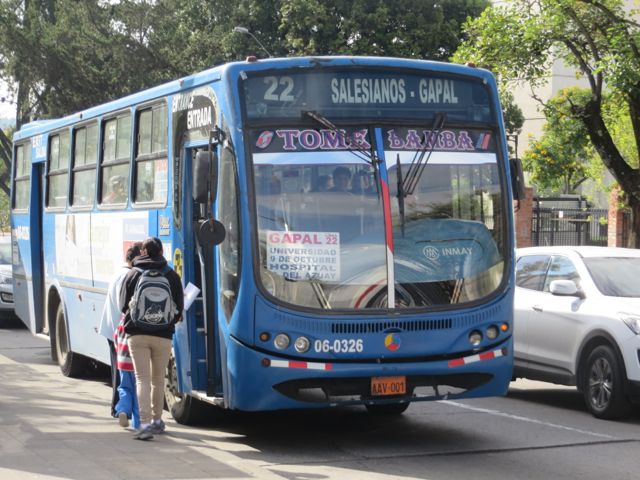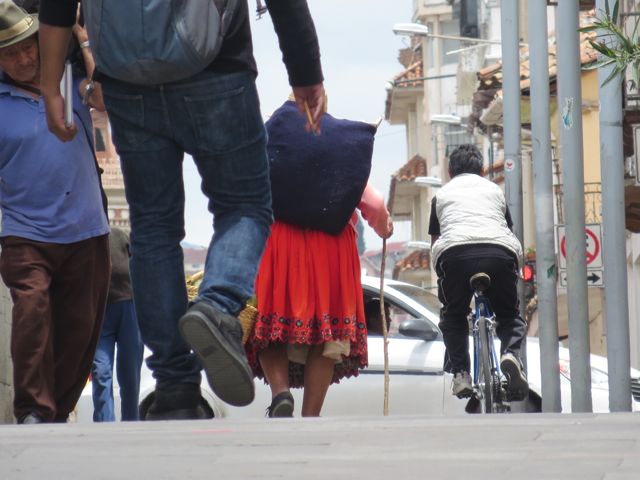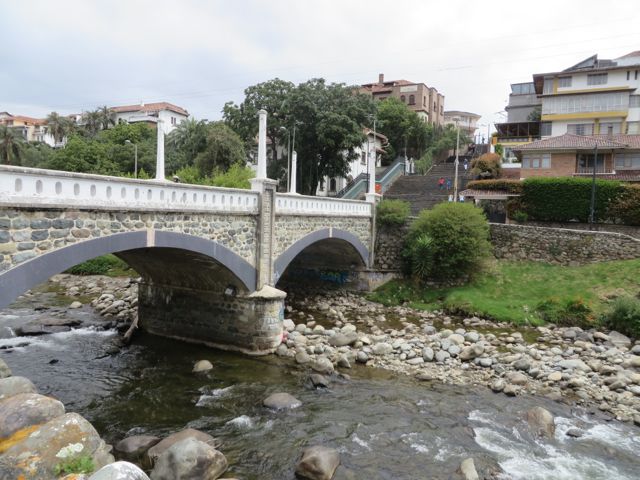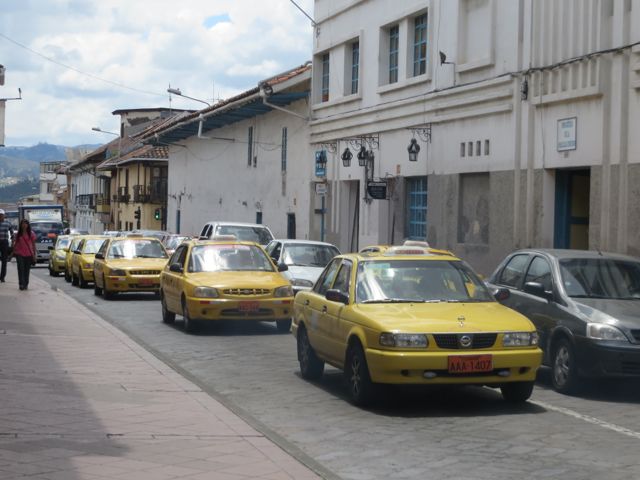Or, rather, the title of this post should be: Taxis, Buses, and Pounding the Pavement
As the sightseeing tapers off a bit while I get ramped up for my class and try to get some projects underway, I’m becoming more adept at making my way around the city and thought I would share a little of my daily life. In Colorado I commute to work via a Prius, listening to my favorite tunes, a new novel, or practicing my Spanish along the way. Here, I breathe diesel fumes and hang on for dear life to a bar above my head while we trundle over cobblestone streets and careen through traffic circles or over speed bumps.

I’ve become very familiar with these beauties in the past couple of weeks! Best to avoid a big lunch right before hopping on board.
I’ve chosen to be a bus commuter here in Cuenca. During my first two weeks here, I commuted via taxi to the satellite campus of la Universidad de Cuenca, where I work – about 4-5 miles from where I live. Every taxi driver took a different route to get there, and that always left me feeling disoriented and isolated on the tiny campus. Taxis aren’t expensive, and the ride would usually cost me $1.60-$2.50 each way. But I’m not a big fan of the ‘taxistas’ – the taxi drivers.
Actually, that’s not entirely fair. I’m always happy when I flag down a taxi and find a driver that has gray hair, is listening to Ecuador’s version of NPR, and knows how to get where I want to go. Even if he doesn’t have seat belts (and most don’t), I know we will go at a steady, reasonable pace down the road. On the other hand, I groan inside every time the taxi pulls up and I find some young punk behind the wheel, proudly displaying his tattoos and blasting his favorite music.
And if you’re wondering, it’s usually not hard to get a taxi. The streets are swimming with them. Sometimes you look out at a sea of yellow – waves of taxis trolling every street – reminiscent of New York City.
I feel more independent taking the bus. But it has it’s challenges. There is no good published bus route map – anywhere. You just have to figure out where they’re going by the list of names displayed in the front window. Each ride costs $.25 – and you better have exact change or a prepaid card. If the machine eats your money because it thinks your coins are no good, well, too bad. You just have to dig around in your pockets for a better coin. Until I figured out where to buy one of those cards that you simply swipe as you enter the bus, my pockets were rattling with change all day. Oh, and no transfers. If you need to take two buses, that will be 50 cents. (BTW – If you’re reading this because you’re planning to visit or live in Cuenca, you can buy one of those ‘prepago’ cards at the Arenal transfer terminal next to Feria Libre. That was something that took me awhile to figure out.)
So my commute to work now involves taking a bus from the corner near my house to the big market center Feria Libre, walking half a block to another bus stop, and waiting for bus #2 to take me to campus. Total transport time: 30 minutes (compared to a 10 minute taxi ride). My other option is to walk 25-30 minutes towards the city center, and take a 10 minute bus ride from there to campus. So that route takes a little more time and involves hitting the pavement.
What’s it like to ride a city bus in Cuenca?
Imagine being on an airplane with lots of turbulence – but the seats are hard plastic, with no seat belts. Some buses are new and shiny (I’m always happy to see a red bus.) Some are very old and dingy. Some drivers choose not to close the doors of the bus, and if you’re forced to stand in the aisle, or near the door, you may spend your time watching the ground race by only a few feet away as you grasp the bars overhead (fortunately, since I’m taller than pretty much everyone here, there’s always enough bar space to grab onto – unless the little kids in the back of the bus decide to use them as monkey bars.) When you want to get off, you have to go to the back of the bus and press a button to let the driver know. He will pause at the next official stop. The doors open before the bus stops moving – and if you’re the only one getting off, don’t dally. As soon as you jump out, he’s off again.
I’ve learned to shut my eyes and hold my breath as the bus leaves me behind, kicking up dust and spewing black clouds. I carry a bottle of water in case I feel grit between my teeth – and hand-sanitizer has become my friend.
So, it’s an adventure. But I like people-watching on the bus. On the Feria Libre route, I see lots of ladies in traditional dress loaded with big sacks. I see school kids decked out in their school uniforms – girls in sweaters, long skirts and stockings, and boys in their slacks and jackets. Every school has a different color theme. Elderly men and women move gracefully and quickly up and down the isles of the moving bus and young kids eat ice cream in the open space next to the driver. On the route from campus to the city center, we pass through ‘Gringolandia’ – the neighborhood with glassy high-rise apartment buildings inhabited by, well, gringos. So I almost always see other gringos on the bus (and often end up talking with them. There’s something about being a foreigner and meeting someone else who speaks your native language.)

Walking is the favored mode of transport for many. On rare occasions I see someone on a bicycle. Cuenca actually has a few streets with bike lanes. But most people just ride on the sidewalk to be safe. As with pedestrians, bikes have no right-of-way on the road. I will probably not use a bike for transport in Ecuador. Although, it’s fine to ride along the river path.
The bus has become my favored mode of transportation to work, but if I go anywhere else in the city, I’m on foot. I’ve become accustomed to walking all over town….south to the mall, north to the city center. A half-hour walk to my Spanish school near Parque Calderon passes quickly when I have so much to look at – and when I can walk by the Rio Tomebamba on a sunny day. Of course, walking has it’s challenges too. As a pedestrian, you are a moving target for vehicles – and you can’t walk anywhere in Ecuador without having to do a little jog across the street every other block. Especially when those buses come along.
And, although walking is presumably a free mode of transport, it’s becoming very clear that I’m wearing out my walking shoes much faster than I thought I would. Keens are great for pounding the pavement, but I really should have brought two pair. A pass through all the shoe stores at the mall turned up nothing but apologies and shrugs when I asked if they carried shoes in a Euro size 40. I now know how my brother has felt his whole life – always standing more than a head taller than everyone else, and having to special-order his shoes.
The first person to come visit me in Ecuador will have to make space in their bags for a new pair of Keen day-hikers from REI. Size 9.5 please. Until then, I’ll just keep treading the streets as lightly as possible!

Fortunately, Cuenca is a very walkable city, with several pedestrian-only bridges, and stairways from the river up to the city center.

Tiffany and Sue here,
We brought you with us on our walk on the Michaud Trail. Beeeautiful. It is wonderfully warm here…and we didn’t have to check with our favorite meteorologist for this one. (She’s a deserter by the way.) Eva is in Italy, in paradise, we’ve heard. Sue is biomatting Denver and soon Fargo. Tiffany is workshopping it this weekend. Which might be too woowoo to speak of on this scientifically oriented blog. We tried to Skype bomb you (you know, leave a Skype video message) but we couldn’t figure it out. We’ll wait for Eva to return to teach us. We love you and hope you are doing well.
LikeLike
That last photo here — I was there at that footbridge!
LikeLike